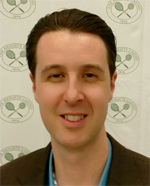Boris Becker's Serve
Nate Chura
Did Boris Becker have one of the greatest serves of all time, not just his own era? What made it so distinctive and effective? How did he develop it? And finally, how does Becker himself feels it compares to pro serves today?
Between 1984 and 1999, Becker won 49 tour singles titles – including six Grand Slams. His knick name was "Boom Boom," as in two booms.
The first boom was the sound of the ball coming off his racket. The second was the sound of it hitting the wall. (To study Becker's serve for yourself in the Tennisplayer Archive, Click Here.)
Becker now works as an analyst for the European cable channel Sky Sports. On the last Friday of the US Open, I stood next to him on the balcony of the Sky Sports set, overlooking the practice courts at the far end of the National Tennis Center.
Below us Rafael Nadal was practicing his serve before his semifinal match the next day against Richard Gasquet. As Rafa hit serves wide in the ad court, Becker shared some thoughts about the serving mechanics of the current generation.

"The players today, Nadal, Djokovic have a pretty open continental grip on the serve," Becker observed. By that he meant that their hands were more on top of the frame, with the palms wrapped around the handle but still pointed somewhat downward at the court.
Becker eviscerated the competition in his day, but his technique was eccentric in many ways. What made it different?
"I had a pretty closed grip," he told me, "and a quite narrow stance, but a low knee bend. To get the power, I had to really get down."
By closed he meant his hand was shifted more to the right, toward the forehand grip, with the hand wrapped more around the handle.
The motion was especially taxing on his knees and legs. To ensure they were strong and healthy enough, he did squats every other day.
But there was another critical factor. "The wrist is the key," he said emphatically. "That's where I got the acceleration and the power and angle. You have to keep it loose."
So where did his technique come from? The answer surprised me.
Andy Roddick discovered his unorthodox serve more or less by accident. But Becker was specifically taught his technical motion by a Slovenian developmental coach named Boris Breskvar.
Virtually unknown in the states, Breskvar had a critical role in the development of players including many great champions Steffi Graf, Anke Huber, Andrei Medvedev, among others.
"Breskvar is the guy who made the ‘Boris Becker' serve," Becker, himself, told me.
"As a young teenager," he continued, "I actually had a pretty bad serve. I was winning matches not because of my serve, but because of my forehand.

Then one day Breskvar said, ‘Listen, we gotta change your serve, because your good, but you're not gonna be that good, because you're too big and too slow. You have to use your power.' So we spent, literally, all weekend just changing the grip totally. I couldn't serve for a while, but I believed him. And then, a few weeks later, I started to really hit that serve."
I wanted to speak with Breskvar to get more insight into the process, but he passed away last year at the age of 71. But I was able to get in touch with his son Peter Breskvar, who has continued his father's line of work in Slovenia.
A prominent coach himself, Peter runs the Breskvar Tennis Academy in the capital city, Ljubljana, and has trained many of the country's top players. (Click Here.) He's also quite familiar with Becker's serve. He used to practice with him when he was a junior.
"I think I still have a positive balance against him," 7-4 in head-to-head," Breskvar remembers, "however, when he was 14 or 15 years old, I started losing, so I did not want to play with him anymore."
When I first wrote Peter, I asked if his father taught him to serve the same way as Becker. Was it a signature coaching technique? To my surprise Peter informed me his father had engineered the serve especially for Boris.
"My father had an incredible eye," Peter told me in an email. "He found an individual technique for each player, one that suited the player best."
"Boris had an especially strong wrist," he explained, "which is the reason why a serve with that grip worked for him. Becker also managed to arch so much during the serve. He went down with his knees and then exploded. "
What about that crossover step with the right foot Boris took into the court? "In the past, many more good players used the crossover step when serving," Peter wrote, naming Rod Laver, John Newcombe and Yannick Noah.
It enables a faster transition towards the net. "This is why my father taught Becker this step. Becker's serve was strong and transition towards the net extremely fast due to the crossover step. Today, the majority land on the first leg."
"Only players with very good coordination/motion control can perform the crossover step. Otherwise it can quickly lead to rotating the shoulders too fast rotation. This is probably the reason why coaches nowadays teach this step much more seldomly."
His father taught Steffi Graf a much more classic motion, with a more traditional grip. "Women have different physical abilities, which is also the reason why the technique of their shots is different."
I asked Peter then whether he teaches the "Becker serve" to any his modern students at his Academy. Like his father he said: "I try to find the best technique for each individual player."
"I could not say that there is one ideal model serve. Each of them is special."
But interestingly, Peter's own son, Gregor Breskvar, who just recently played his first challenger at the age of 18, serves with a grip very similar to Becker.
"He also has a very strong wrist," Peter explained.
Before I left the Sky Sports set at the Open, I asked Becker if his serve could be effective in the modern game.
"The serve is a very personal thing," Becker answered. "It's the only stroke in tennis that you only decide yourself, without the opposition playing a part of it.
"These guys like Nadal were born baseliners and used the serve much later into their game, whereas players in my day such as Edberg and Sampras were born servers and used the baseline later in their games.
"You can argue, which generation had the better serves? But I like to think it was us."





